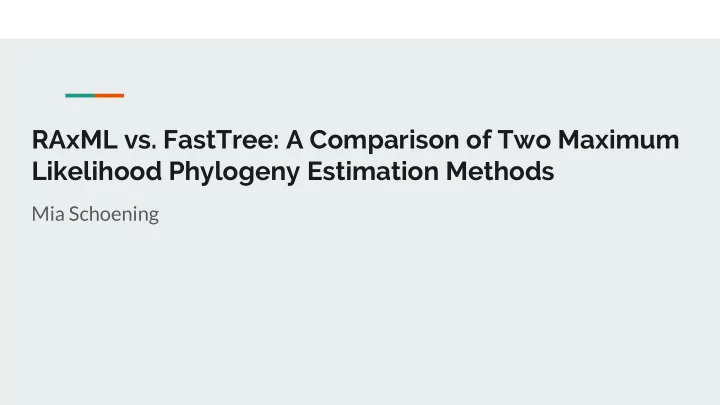

RAxML vs. FastTree: A Comparison of Two Maximum Likelihood Phylogeny Estimation Methods Mia Schoening
RAxML vs. FastTree RAxML FastTree ● ● Implements standard SPR-based Uses combination of Neighbor-Joining, ○ ○ hill-climbing algorithm Minimum Evolution, and ML-based NNI Main method used for large-scale ML rearrangement methods ○ phylogeny estimation Can handle alignments up to 1 million ○ Computational requirements limit sequences ○ number of sequences and sites On large alignments, orders of magnitude ○ faster than RAxML and PhyML
RAxML vs. FastTree RAxML FastTree ● ● Implements standard SPR-based Uses combination of Neighbor-Joining, ○ ○ hill-climbing algorithm Minimum Evolution, and ML-based NNI Main method used for large-scale ML rearrangement methods ○ phylogeny estimation Can handle alignments up to 1 million ○ Computational requirements limit sequences ○ number of sequences and sites On large alignments, orders of magnitude ○ faster than RAxML and PhyML When is it necessary to use RAxML over FastTree?
Model Tree Sequence Type: DNA ● Number of Sequences: 1001 ● Sequence Length: 5000 sites ●
Generating Model Tree Set Branch Length ● Small: x10 ○ Moderate: x50 ○ Large: x100 ○ Number of Leaves ● Dense: 1001 Taxa ○ Sparse: 50 Taxa ○
Generating Model Tree Set Branch Length ● 1. Small-Sparse Small: x10 ○ 2. Small-Dense Moderate: x50 ○ 3. Moderate-Sparse Large: x100 ○ 4. Moderate-Dense Number of Leaves ● 5. Large-Sparse Dense: 1001 Taxa ○ Sparse: 50 Taxa 6. Large-Dense ○
Software Versions RAxML Version 8.2.12 FastTree Version 2.1.10
Running Time Analysis
ML Scores (as log likelihoods) Small_Sparse Small_Dense Moderate_Sparse Moderate_Dense Large_Sparse Large_Dense -210,099 -3,387,957 -242,980 -4,324,461 -253,999 -4,571,306 FastTree -207,591 -3,366,916 -240,882 -4,277,753 -252,064 -4,519,003 RAxML
Tree Topology Analysis
Discussion RAxML consistently outperforms FastTree with respect to ML scores and tree topology, but at the ● cost of longer running times Both methods had higher RF error values on sparse datasets than dense datasets ● As edge lengths increased, RF error values increased for both methods ●
References Liu K, Linder CR, Warnow T (2011) RAxML and FastTree: Comparing Two Methods for Large-Scale Maximum Likelihood Phylogeny Estimation. PLoS ONE 6(11): e27731. https://doi.org/10.1371/journal.pone.0027731 Price, M.N., Dehal, P.S., and Arkin, A.P. (2010) FastTree 2 -- Approximately Maximum-Likelihood Trees for Large Alignments. PLoS ONE, 5(3):e9490. doi:10.1371/journal.pone.0009490. Stamatakis, A. (2014) RAxML Version 8: A tool for Phylogenetic Analysis and Post-Analysis of Large Phylogenies. Bioinformatics 30 (9): 1312-1313. Xiaofan Zhou, Xing-Xing Shen, Chris Todd Hittinger, Antonis Rokas (2018) Evaluating Fast Maximum Likelihood-Based Phylogenetic Programs Using Empirical Phylogenomic Data Sets, Molecular Biology and Evolution , 35(2):486–503, https://doi.org/10.1093/molbev/msx302
Recommend
More recommend